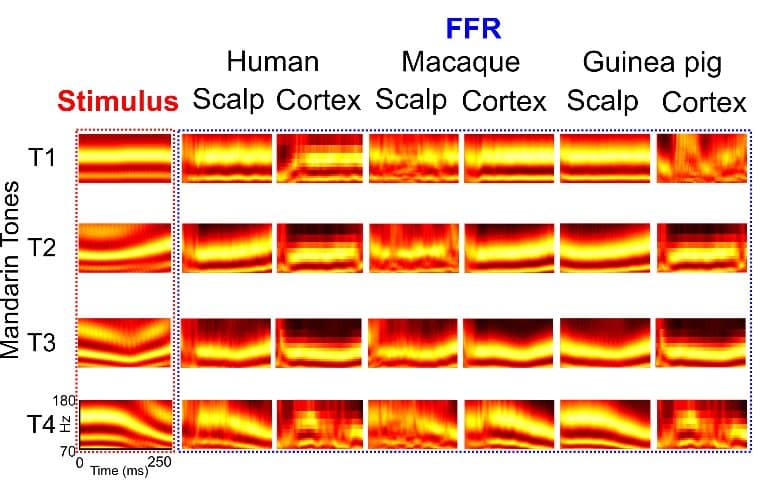Summary: The sound of speech elicits similar neural responses and stimulates the same brain regions in humans, guinea pigs, and macaque monkeys.
Source: University of Pittsburgh
Speech sounds elicit comparable neural responses and stimulate the same region in the brain of humans, macaques and guinea pigs, a multidisciplinary group of University of Pittsburgh researchers reported in the journal eNeuro. The finding could help pave the way for better understanding and diagnosis of auditory processing deficits.
The brain’s responses to sound—called frequency-following responses, or FFRs,—can be recorded from small electrodes placed onto a person’s scalp. They are used by clinicians to quickly assess a child’s hearing capacity and flag a slew of potential speech and language disorders, such as dyslexia and autism. But the method has a major drawback: It is lacking specificity.
“These tests can only tell us that something is off—but we don’t know what that ‘off’ is,” said co-corresponding author Bharath Chandrasekaran, Ph.D., professor and vice chair for research in the Department of Communication Science and Disorders at Pitt’s School of Health and Rehabilitation Sciences.
“Understanding the source and mechanism of FFR generation would allow for the development of specific markers of speech impairments, which would be instrumental in improving clinical diagnostics of auditory processing deficits.”
The FFRs—which show up on a neurotypical brain electroencephalogram as a near carbon copy of the sound wave that the brain is interpreting and responding to—have the potential to complement hearing screening of newborns. If the baby’s brain produces an electrical response to a sound played though tiny headphones, then the neural pathway connecting the ear to the high-level information processing center in the brain cortex is developed and functional.
The FFRs are also used to identify any issues in auditory processing, or the way that the brain interprets sounds coming from the environment, especially speech. The closer the FFR profile resembles the profile of the sound source, the stronger the brain’s auditory processing capacity. In contrast, the more different the two profiles are, the higher the chances of diagnosing an auditory deficit.
Until recently, scientists thought that FFRs arise deep inside the brain stem—the brain’s innermost structures close to the base of the skull—and ripple outward, eventually reaching the surface of the brain and the scalp.
By combining electroencephalographic recordings from the scalp with recordings from electrodes placed inside the skull, Pitt researchers proved the long-standing theory wrong. They found that FFRs are generated not only at the brain stem, but also in the auditory cortex of the brain—the region responsible for the processing of sounds located right around the temple, only a few centimeters away from the surface of the skull—and that the pattern of FFR generation is similar across mammals.

In response to four different tones of the Mandarin syllable “yi,” the brains of English-speaking individuals who aren’t familiar with Mandarin Chinese generated similar FFRs as macaque monkeys and guinea pigs, both of which have very similar hearing range and sensitivity to humans.
“Recognizing the similarities between animal and human FFRs will allow us to study neural circuitry of sound processing in much greater detail,” said lead author Nike Gnanateja Gurindapalli, Ph.D., postdoctoral fellow at Pitt. “These explorations will further pave the way for new models of auditory processing in both typical and impaired auditory systems, which can eventually be used to infer auditory deficits using simple and effective non-invasive tools in the clinic.”
Because FFRs were traditionally thought to be generated outside the cortex in a passive way, researchers typically do not account for the degree of a person’s attention and alertness during the FFR recording. But the new discovery suggests the need to reconsider the way FFRs are collected and how they are interpreted and sets the scene for the development of better biomarkers of auditory processing deficits.
Between 5% and 10% of Americans have diagnosed communication disorders, researchers say. A better understanding of the way auditory deficits manifest in the brain can fill a critical gap in the development of fast, accurate and non-invasive diagnostics.
About this auditory neuroscience research news
Author: Press Office
Source: University of Pittsburgh
Contact: Press Office – University of Pittsburgh
Image: The image is credited to Nike Gnanateja Gurindapalli
Original Research: Closed access.
“Frequency-following responses to speech sounds are highly conserved across species and contain cortical contributions” by Bharath Chandrasekaran et al. eNeuro
Abstract
Frequency-following responses to speech sounds are highly conserved across species and contain cortical contributions
Time-varying pitch is a vital cue for human speech perception. Neural processing of time-varying pitch has been extensively assayed using scalp-recorded frequency-following responses (FFRs), an electrophysiological signal thought to reflect integrated phase-locked neural ensemble activity from subcortical auditory areas. Emerging evidence increasingly points to a putative contribution of auditory cortical ensembles to the scalp-recorded FFRs. However, the properties of cortical FFRs and precise characterization of laminar sources are still unclear.
Here we used direct human intracortical recordings as well as extra- and intracranial recordings from macaques and guinea pigs to characterize the properties of cortical sources of FFRs to time-varying pitch patterns. We found robust FFRs in the auditory cortex across all species.
We leveraged representational similarity analysis as a translational bridge to characterize similarities between the human and animal models. Laminar recordings in animal models showed FFRs emerging primarily from the thalamorecepient layers of the auditory cortex. FFRs arising from these cortical sources significantly contributed to the scalp-recorded FFRs via volume conduction.
Our research paves the way for a wide array of studies to investigate the role of cortical FFRs in auditory perception and plasticity.
Significance Statement
Frequency following responses (FFRs) to speech are scalp-recorded neural signals that inform the fidelity of sound encoding in the auditory system. FFRs, long believed to arise from brainstem and midbrain, have shaped our understanding of sub-cortical auditory processing and plasticity. Non-invasive studies have shown cortical contributions to the FFRs, however, this is still actively debated.
Here we employed direct cortical recordings to trace the cortical contribution to the FFRs and characterize the properties of these cortical FFRs. With extra-cranial and intra-cranial recordings within the same subjects we show that cortical FFRs indeed contribute to the scalp-recorded FFRs, and their response properties differ from the sub-cortical FFRs.
The findings provide strong evidence to revisit and reframe the FFR driven theories and models of sub-cortical auditory processing and plasticity with careful characterization of cortical and sub-cortical components in the scalp-recorded FFRs.






